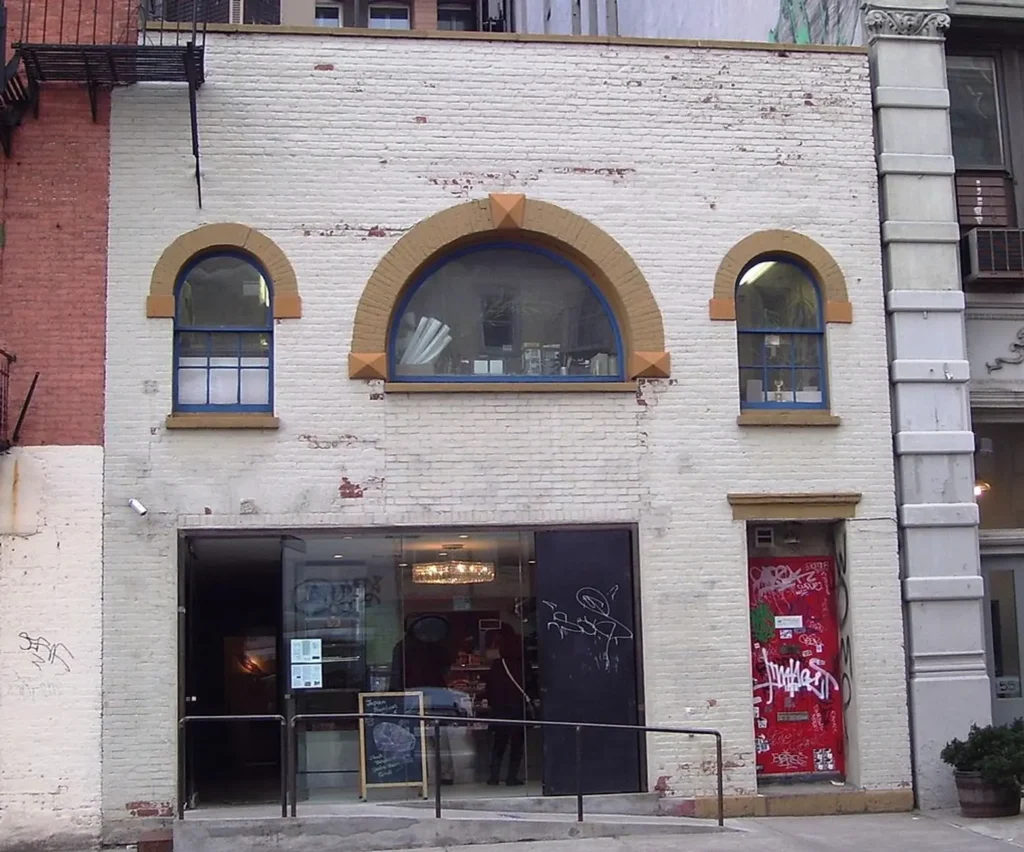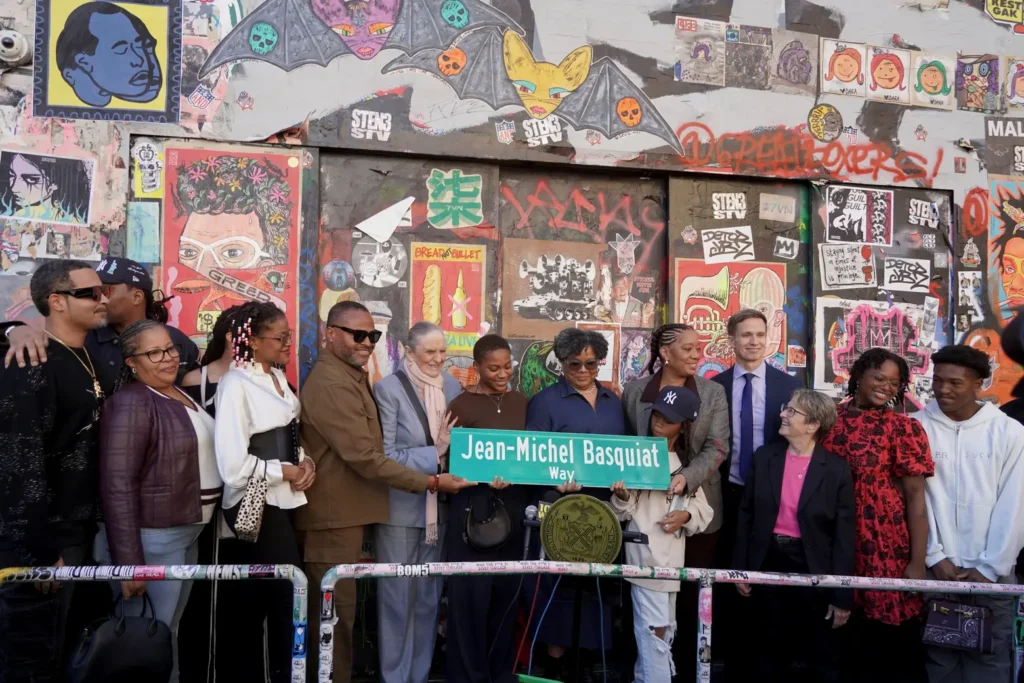the announcement
On October 21, 2025, New York City unveiled a new street sign in Lower Manhattan’s NoHo district reading Jean-Michel Basquiat Way, officially co-naming the block of Great Jones Street between Bowery and Lafayette. The event gathered city officials, Basquiat’s sisters Lisane and Jeanine, local artists, and longtime friends of the painter whose energy once defined the downtown art scene.
The site carries immense weight in art history. At 57 Great Jones Street stands the former studio Basquiat occupied from 1983 until his death in 1988. The building, owned at the time by Andy Warhol, remains a pilgrimage point—its walls a living canvas of graffiti, tags, and tributes to the artist who fused poetry, anger, rhythm, and intellect into paint.
the artist and the city
Jean-Michel Basquiat was born in Brooklyn in 1960, the son of a Haitian father and a Puerto Rican mother. From childhood, he exhibited an instinctive grasp of language, drawing, and symbolism. New York was his classroom: museums, subways, record stores, and the cracked pavements of SoHo.
By the late 1970s he became half of the enigmatic graffiti duo SAMO, spraying riddled aphorisms on downtown walls—epigrams that poked at capitalism, art snobbery, and existential angst. When those cryptic messages began to circulate through SoHo’s gallery corridors, Basquiat transformed from anonymous tagger to prodigious painter.
The city that had once been his canvas became his subject. Basquiat’s canvases mirrored the rough pulse of the streets: fragments of anatomy, jazz notes, words like sugar cane and asbestos, and his now-ubiquitous crown symbol. His work collapsed distinctions between the urban outsider and the high-art insider, between Black experience and Western canon, between chaos and control.
the great jones years
When Basquiat moved into 57 Great Jones Street in 1983, he was already a name whispered among dealers and critics. The building, a narrow loft once used as a stable, was owned by Andy Warhol, who rented it to him as both living quarters and studio.
Those five years were prolific. Basquiat produced some of his most iconic paintings there—Defacement (The Death of Michael Stewart), Boy and Dog in a Johnnypump, and dozens of untitled works pulsing with frenetic color and coded rage.
Visitors recalled the studio as a mix of chaos and clarity: jazz spinning on vinyl, piles of books, canvases stacked against walls, and a constant flow of friends, collaborators, and musicians. Keith Haring, Fab 5 Freddy, and Warhol himself were frequent presences. The space became an epicenter of downtown culture, bridging the Bowery’s grit and SoHo’s new-money allure.
Basquiat’s passing there in August 1988 at only twenty-seven marked the end of an era—but the building’s façade remained a living tribute, layered with street art and tags from succeeding generations who regarded him as a prophet.
the ceremony
The 2025 co-naming ceremony unfolded on an unseasonably warm afternoon. Under the autumn light, Basquiat’s sisters unveiled the emerald-green sign bearing his name. City officials spoke of his enduring influence; local artists painted small crowns on the sidewalks nearby.
For the Basquiat family, it was both public honor and personal closure. Lisane Basquiat addressed the crowd: “Jean-Michel belonged to this city. Every mark he left here was an act of love and resistance. This sign ensures he never leaves.”
The street naming was the culmination of community advocacy spanning several years, supported by local councils and cultural organizations. It acknowledges Basquiat not merely as a market phenomenon or fashion motif, but as a New Yorker who transformed language, race, and urban energy into art that the world continues to read.
a new geography of memory
Cities remember through names. To attach Basquiat’s to a street is to inscribe art into infrastructure. It turns memory into direction—an address rather than an abstraction. Pedestrians who look up at “Jean-Michel Basquiat Way” encounter history embedded in the grid.
The gesture matters beyond symbolism. In a metropolis often accused of erasing its bohemian past through gentrification, the sign asserts continuity. Great Jones Street, once home to stables, speakeasies, and Warhol’s studio, now also carries a reminder of creative rebellion.
The block will likely become a cultural waypoint: a stop on art tours, an image shared on social media, a pilgrimage site for those tracing the lineage of modern creativity. Like Prince Street or Bleeker Street, it joins the pantheon of names that speak to both geography and myth.
basquiat’s extended influence
Basquiat’s reach stretches far beyond painting. His raw aesthetic and fractured poetics infiltrate fashion, music, and design. Brands continually return to his iconography—three-point crowns, skeletal figures, scrawled text—as shorthand for authenticity and intellect.
In fashion, his work has adorned everything from luxury house collaborations to streetwear capsules. Designers cite him as a patron saint of creative hybridity, someone who blurred class and category. In hip-hop, his legend persists through lyrics, visuals, and even personal emulation: rappers referencing him as a model of artistic transcendence.
Museums continue to mount retrospectives, but the street naming signals something different: an act of democratization. Where galleries enclose, streets expose. Basquiat’s name now hangs in public space—visible to cab drivers, delivery cyclists, and tourists alike. It’s a fitting echo of how he began: writing messages for everyone, not just collectors.
flow
Commemorating a radical within an increasingly sanitized neighborhood poses contradictions. The NoHo of today bears little resemblance to the rough-edged district Basquiat inhabited. Galleries have been replaced by boutiques, lofts by luxury condos. Yet perhaps that’s precisely why the city’s gesture resonates.
The naming both sanctifies and critiques. It asks what kind of city honors the artist it once marginalized. Basquiat spent much of his life confronting exclusion—from racial prejudice to art-world tokenism. Now, decades later, the same city that once struggled to categorize him elevates him among its pantheon.
Critics might call it gentrified nostalgia; admirers, a long-overdue correction. Both readings coexist, reflecting Basquiat’s own tension between fame and rebellion. Even as his name appears on a street sign, the spirit of his work—restless, questioning, alive—resists containment.
the power of naming
Street names outlive trends. They guide maps, frame conversations, orient lives. For a creative spirit like Basquiat, whose art devoured words and symbols, this permanence is poetically apt. A name on a street corner accomplishes what a gallery cannot: integration into daily life.
Taxi drivers will call it out; directions will be given by it. It joins a lexicon of memory alongside Duke Ellington Boulevard and Malcolm X Boulevard—icons whose lives shifted American consciousness.
In a deeper sense, “Basquiat Way” aligns with his obsession with language itself. His canvases were dialogues of words and marks. Now the city speaks his name back to its people. It’s not just a tribute—it’s an ongoing conversation between art and place.
continuity
Basquiat’s legacy thrives wherever artists remix sound and image, wherever marginalized voices claim visibility. Downtown New York remains fertile ground for such reinvention. Street murals, pop-up galleries, and collectives echo his improvisational method.
The sign at Great Jones Street becomes a connective thread linking generations: from graffiti writers to contemporary muralists, from punk photographers to digital artists. His story reminds young creators that defiance can become definition, that cultural resistance can enter the city’s official vocabulary.
from loft to legend
Standing outside 57 Great Jones Street today, one can still sense the residue of creation. Layers of tags, notes, and stencil crowns coat the doorway. Tourists pose for photos; locals pass without pause. It’s both shrine and sidewalk—a duality Basquiat would have appreciated.
Now the street name elevates that tension to the civic level. “Jean-Michel Basquiat Way” is not tucked behind museum walls but woven into daily traffic. It’s a rare instance where bureaucracy meets poetry: municipal metal carrying the energy of a man who refused boundaries.
impression
The naming of Jean-Michel Basquiat Way transforms memory into geography. It immortalizes a voice that chronicled the beauty and brutality of urban life and ensures that his legacy remains tethered to the very streets that inspired it.
As night falls on Great Jones Street, the green sign catches the glow of passing headlights. Around it, the city hums—taxis, subway grates, conversations in a dozen languages. Basquiat’s New York has changed, but the rhythm endures. His art was always about the collision of forces—language and silence, wealth and poverty, life and death. The new street name is yet another collision: between the permanence of civic recognition and the volatility of creative genius.
Decades after his final brushstroke, the city still speaks his name. And now, it does so through every map, every set of directions, every glance upward: Jean-Michel Basquiat Way—a street that doubles as an open-air museum, a reminder that art once lived here and, in spirit, never left.
No comments yet.










